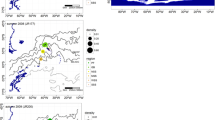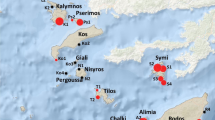Abstract
The 17-year time-series study at Station M in the NE Pacific has provided one of the longest datasets on deep-sea ophiuroids to date. Station M is an abyssal site characterized by low topographical relief and seasonal and interannual variation in surface-derived food inputs. From 1989 to 2005, over 31,000 ophiuroid specimens were collected. Size–frequency distributions of the four dominant species, Ophiura bathybia, Amphilepis patens, Amphiura carchara and Ophiacantha cosmica, were examined for recruitment and the role of surface-derived food supplies on body size distributions. Juveniles were collected in sediment traps and used to investigate settlement patterns and seasonality. Trawl samples showed no indication of seasonal changes in recruitment to larger size classes; however, there was evidence of seasonal settling of juveniles. Interannual differences in median disk diameters and size distributions of trawl-collected adults are greater than those at the seasonal scale. Three of the four species, O. bathybia, A. patens and O. cosmica, had co-varying monthly median disk diameters, suggesting they may have a similar factor(s) controlling their growth and abundance. Interannual differences in monthly size distributions were generally greater than those between seasons. Cross-correlations between the particulate organic carbon (POC) flux (food supply) and size distribution indices for O. bathybia, A. patens and O. cosmica all were significant indicating that increases in food supply were followed by increases in the proportion of smaller size classes after approximately 17–22 months. These findings suggest that food inputs are indeed an important factor influencing deep-sea ophiuroid populations on interannual time scales, more generally supporting the long-hypothesized connection between food availability and population size structure in the deep sea.




Similar content being viewed by others
References
Baldwin RJ, Glatts RC, Smith KL Jr (1998) Particulate matter fluxes into the benthic boundary layer at a long time-series station in the abyssal NE Pacific: composition and fluxes. Deep Sea Res II 45:643–665
Beaulieu SE (2001) Life on glass houses: sponge stalk communities in the deep sea. Mar Biol 138:803–817
Behrenfeld MJ, Boss E, Siegel DA, Shea DM (2005) Carbon-based ocean productivity and phytoplankton physiology from space. Global Biogeochem Cycles 19:GB1006. doi:10.1029/2004GB002299
Billett DSM, Bett BJ, Rice AL, Thurston MH, Galéron J, Sibuet M, Wolff GA (2001) Long-term change in the megabenthos of the Porcupine Abyssal Plain (NE Atlantic). Prog Oceanogr 50:325–348
Bowmer T (1982) Reproduction in Amphiura filiformis (Echinodermata: Ophiuroidea): seasonality in gonad development. Mar Biol 69:281–290
Clarke KR, Warwick RM (2001) Changes in marine communities: an approach to statistical analysis and interpretation. Plymouth Marine Laboratory, UK
Dearborn JH (1977) Foods and feeding characteristics of Antarctic asteroids and ophiuroids. In: Adaptations within Antarctic ecosystems. Smithsonian Institution, Washington, pp 293–326
Drazen JC, Baldwin RJ, Smith KL Jr (1998) Sediment community response to a temporally varying food supply at an abyssal station in the NE pacific. Deep Sea Res II 45:893–913
Druffel ERM, Bauer JE, Williams PM, Griffin S, Wolgast D (1996) Seasonal variability of particulate organic radiocarbon in the northeast Pacific Ocean. J Geophys Res 101(C9):20543–20552
Falkner I, Byrne M (2003) Reproduction of Ophiactis resiliens (Echinodermata: Ophiuroidea) in New South Wales with observations on recruitment. Mar Biol 143:459–466
Fell HB (1961) The fauna of the Ross Sea. Part 1. Ophiuroidea. NZOI Mem 18:1–79
Gage JD (1994) Recruitment ecology and age structure of deep-sea invertebrate populations. In: Young CM, Eckelbarger KJ (eds) Reproduction, larval biology and recruitment of the deep-sea benthos. Columbia University Press, New York, pp 223–242
Gage JD, Tyler PA (1981a) Non-viable seasonal settlement of larvae of the upper bathyal brittle star Ophiocten gracilis in the Rockall Trough abyssal. Mar Biol 64:153–161
Gage JD, Tyler PA (1981b) Re-appraisal of age composition, growth and survivorship of the deep-sea brittle star Ophiura ljungmani from size structure in a sample time series from the Rockall Trough. Mar Biol 64:163–172
Gage JD, Tyler PA (1982a) Depth-related gradients in size structure and the bathymetric zonation of deep-sea brittle stars. Mar Biol 71:299–308
Gage JD, Tyler PA (1982b) Growth and reproduction in the deep-sea brittle star Ophiomusium lymani Wyville Thomsen. Oceanol Acta 5:73–83
Gage JD, Anderson RM, Tyler PA, Chapman R, Dolan E (2004) Growth, reproduction and possible recruitment variability in the abyssal brittle star Ophiocten hastatum (Ophiuroidea: Echinodermata) in the NE Atlantic. Deep Sea Res I 51:849–864
Gooday AJ (2002) Biological responses to seasonally varying fluxes of organic matter to the ocean floor: a review. J Oceanogr 58:305–322
Hendler G, Tran LU (2001) Reproductive biology of a deep-sea brittle star Amphiura carchara (Echinodermata: Ophiuroidea). Mar Biol 138:113–123
Lampitt RS, Sumida PYG, Pérez-Castillo F (2002) Ophiuroid growth within deep-sea sediment traps: a problem for carbon flux measurements at continental margins. Limnol Oceanogr 47:571–575
Lauerman LML (1998) Deep-sea epibenthic echinoderms and temporally varying food supply: results from a long time-series study in the abyssal N.E. Pacific. Ph. D. Thesis. Scripps Institution of Oceanography, UCSD
Lauerman LML, Kaufmann RS (1998) Deep-sea epibenthic echinoderms and a temporally varying food supply: results from a one year time series in the NE Pacific. Deep Sea Res II 45:817–842
Lauerman LML, Kaufmann RS, Smith KL Jr (1996) Distribution and abundance of epibenthis megafauna at a long time-series station in the abyssal northeast Pacific. Deep Sea Res I 43:1075–1103
Laws EA (2004) Export flux and stability as regulators of community composition in pelagic marine biological communities: implications for regime shifts. Prog Oceanogr 60:343–354
Lightfoot RH, Tyler PA, Gage JD (1979) Seasonal reproduction in deep-sea bivalves and brittlestars. Deep Sea Res 26A:967–973
Pearson M, Gage JD (1984) Diets of some deep-sea brittle stars in the Rockall Trough. Mar Biol 82:247–258
Rokop FJ (1974) Reproductive patterns in the deep-sea benthos. Science 186:743–745
Ruhl HA (2007) Abundance and size distribution dynamics of abyssal epibenthic megafauna in the northeast Pacific. Ecology 88(5):1250–1262
Ruhl HA, Smith KL Jr (2004) Shifts in the deep-sea community structure linked to climate and food supply. Science 305:513–515
Schoener A (1967) Post-larval development of five deep-sea ophiuroids. Deep Sea Res 14:645–660
Schoener A (1968) Evidence for reproductive periodicity in the deep sea. Ecology 49:81–87
Schoener A (1972) Fecundity and possible mode of development of some deep-sea ophiuroids. Limnol Oceanogr 17:193–199
Sköld M, Josefson AB, Loo L-O (2001) Sigmoidal growth in the brittle star Amphiura filiformis (Echinodermata: Ophiuroidea). Mar Biol 139:519–526
Smith KL Jr, Druffel ERM (1998) Long time-series monitoring of an abyssal site in the NE Pacifc: an introduction. Deep Sea Res II 45:573–586
Smith KL Jr, Baldwin RJ, Ruhl HA (2006) Climate effect on food supply on depths greater than 4, 000 meters in the northeast Pacific. Limnol Oceanogr 51(1):166–176
Sumida PYG, Gage JD, Norrevang A (1998) Postlarval development in shallow and deep-sea ophiuroids (Echinodermata: Ophiuroidea) of the NE Atlantic Ocean. Zool J Linn Soc 124:267–300
Sumida PYG, Tyler PA, Lampitt RS, Gage JD (2000) Reproduction, dispersal and settlement of the bathyal ophiuroid Ophiocten gracilis in the NE Atlantic Ocean. Mar Biol 137:623–630
Turon X, Codina M, Tarjuelo I, Uriz MJ, Becerro MA (2000) Mass recruitment of Ophiothrix fragilis (Ophiuroidea) on sponges: settlement patterns and post-settlement dynamics. Mar Ecol Prog Ser 200:201–212
Tyler PA (1988) Seasonality in the deep sea. Oceanogr Mar Biol Annu Rev 26:227–258
Tyler PA, Gage JD (1979) Reproductive ecology of deep-sea ophiuroids from the Rockall Trough. In: Naylor E, Hartnoll RD (eds) Cyclic phenomena in marine plants and animals. Pergamon Press, Oxford, pp 215–222
Tyler PA, Gage JD (1980) Reproduction and growth of the deep-sea brittlestar Ophiura ljungmani (Lyman). Oceanol Acta 3:177–185
Tyler PA, Gage JD (1982) The reproductive biology of Ophiacantha bidentata (Echinodermata: Ophiuroidea) from the Rockall Trough. J Mar Biol Assoc UK 62:45–55
Tyler PA, Grant A, Pain SL, Gage JD (1982) Is annual reproduction in deep-sea echinoderms a response to variability in their environment? Nature 300:747–750
Wakefield WW, Smithey WM (1989) Two camera sleds for quantitative studies of deep-sea megafauna. SIO Ref Ser 89:xx–14
Young CM (1994) The biology of external fertilization in deep-sea echinoderms. In: Young CM, Eckelbarger KJ (eds) Reproduction, larval biology and recruitment of the deep-sea benthos. Columbia University Press, New York, pp 179–200
Young CM (2003) Reproduction, development and life-history traits. In: Tyler PA (ed) Ecosystems of the deep oceans. Ecosystems of the world. Volume 28. Elsevier, Amsterdam, pp 381–426
Acknowledgments
The authors wish to express our appreciation to the Scripps Institution of Oceanography Benthic Invertebrate Collection for access to material. Authors also thank Cathy Groves of the Echinoderm Collection at the Los Angeles County Museum of Natural History for assistance in facilitating the loan of a considerable amount of material. The taxonomic identifications and systematic guidance provided by Michael A. Kyte (Entrix: Environmental and Natural Resource Management Consultants) and Gordon L. Hendler (Natural History Museum of Los Angeles County) regarding the scarcer ophiuroid species was invaluable. We thank Lynn Lauerman and Jane Chung for assisting in disk diameter measurements and Megan Lilly (City of San Diego, Metropolitan Wastewater Department) for initial taxonomic assistance, and Mati Kahru and Ron Kaufmann for their assistance in processing the satellite data used in the POC flux composite. This paper is dedicated to John S. Tomer. Research was conducted primarily at the Scripps Institution of Oceanography and funded by National Science Foundation grants, OCE89-22620, OCE92-17334, OCE98-07103, OCE11-02385 and OCE02-42472 to KLS, and the David and Lucile Packard Foundation.
Author information
Authors and Affiliations
Corresponding author
Additional information
Communicated by C.L. Griffiths.
Electronic supplementary material
Below is the link to the electronic supplementary material.
Rights and permissions
About this article
Cite this article
Booth, J.A.T., Ruhl, H.A., Lovell, L.L. et al. Size–frequency dynamics of NE Pacific abyssal ophiuroids (Echinodermata: Ophiuroidea). Mar Biol 154, 933–941 (2008). https://doi.org/10.1007/s00227-008-0982-3
Received:
Accepted:
Published:
Issue Date:
DOI: https://doi.org/10.1007/s00227-008-0982-3




